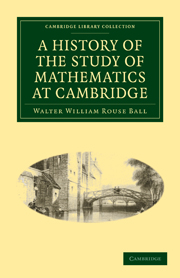Book contents
- Frontmatter
- PREFACE
- Contents
- Chapter I Mediæval mathematics
- Chapter II The mathematics of the renaissance
- Chapter III The commencement of modern mathematics
- Chapter IV The life and works of Newton
- Chapter V The rise of the Newtonian school
- Chapter VI The later Newtonian school
- Chapter VII The analytical school
- Chapter VIII The organization and subjects of education
- Chapter IX The exercises in the schools
- Chapter X The mathematical tripos
- Chapter XI Outlines of the history of the university
- INDEX
Chapter III - The commencement of modern mathematics
Published online by Cambridge University Press: 07 September 2010
- Frontmatter
- PREFACE
- Contents
- Chapter I Mediæval mathematics
- Chapter II The mathematics of the renaissance
- Chapter III The commencement of modern mathematics
- Chapter IV The life and works of Newton
- Chapter V The rise of the Newtonian school
- Chapter VI The later Newtonian school
- Chapter VII The analytical school
- Chapter VIII The organization and subjects of education
- Chapter IX The exercises in the schools
- Chapter X The mathematical tripos
- Chapter XI Outlines of the history of the university
- INDEX
Summary
In the last chapter I was able to trace a continuous succession of mathematicians resident at Cambridge to the end of the sixteenth century. The period of the next thirty years is almost a blank in the history of science at the university, but its close is marked by the publication of some of the more important works of Briggs, Oughtred, and Harriot. We come then to the names of Horrox and Seth Ward, both of whom were well-known astronomers; to Pell, who was later in intimate relations with Newton; and lastly to Wallis and to Barrow, who were the first Englishmen to treat mathematics as a science rather than as an art, and who may be said to have introduced the methods of modern mathematics into Britain. It curiously happened that in the absence of any endowments for mathematics at Cambridge both Ward and Wallis were elected to professorships at Oxford, and by their energy and tact created the Oxford mathematical school of the latter half of the seventeenth century.
The middle of the seventeenth century marks the beginning of a new era in mathematics. The invention of analytical geometry and the calculus completely revolutionized the development of the subject, and have proved the most powerful instruments of modern progress. Descartes's geometry was published in 1637 and Cavalieri's method of indivisibles, which is equivalent to integration regarded as a means of summing series, was introduced a year or so later. The works of both these writers were very obscure, but they had a wide circulation, and we may say that by about 1660 the methods used by them were known to the leading mathematicians of Europe.
- Type
- Chapter
- Information
- A History of the Study of Mathematics at Cambridge , pp. 33 - 50Publisher: Cambridge University PressPrint publication year: 2009First published in: 1889



